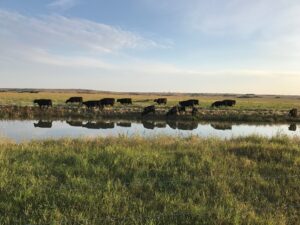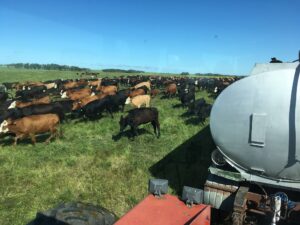Water Systems: New Web Page
Remarque : cette page web n’est actuellement disponible qu’en anglais.

Editor’s note: Relevant and up-to-date information that had been available on Foragebeef.ca is gradually being added to BeefResearch.ca. (More information). The new Water Systems for Beef Cattle page, which is previewed below, is one example. Further webpages will be added or updated on BeefResearch.ca to include the valuable content from Foragebeef.ca, ensuring that information remains freely available online. Completion is expected by Spring 2020.
Water is an essential nutrient for cattle, accounting for between 50 and 80 percent of an animal’s live weight. For livestock to maximize feed intake and production, they require access to palatable water of adequate quality and quantity. Factors that determine water consumption include water quality, air and water temperature, humidity, moisture content of feed/forage, cattle type (calf, yearling, bull, cow) and the physiological state of the animal (gestation, maintenance, growing, lactating). Producers must consider individual grazing management strategies, site characteristics and economics when designing water systems.
For optimum health, cattle need a consistent source and adequate supply of water on a daily basis. Water quality and intake will affect cattle growth and performance. Access to fresh, clean water increases animals’ water intake, which in turn, increases their dry matter intake. This improves animal performance.
Water consumption will vary based upon water quality, air and water temperature, humidity, moisture content of feed/forage, class of livestock, animal weight, and the physiological state of the animal. Heavier cattle have greater total daily water intake requirements as do lactating cattle compared to non-lactating cattle. Minimum water requirements are needed for growth, fetal development or lactation, water loss through urine, feces, sweat, or evaporation from lungs or skin. Factors that influence these needs will impact water requirements. For example, if cattle consume a diet high in protein, salt, minerals or diuretic substances, water needs will increase. If environmental temperature or physical activity increases, water losses through evaporation and sweating will also increase, resulting in increased water needs.
As a key nutrient required by cattle, water of suitable quality must be provided consistently to meet drinking needs. While cattle can be maintained on lower quality water sources, their health and performance can be negatively affected. Conducting baseline water tests to determine important parameters of water quality will assist producers in identifying whether a water source is suitable.

Water quality can change from year to year, and in certain instances, can even change over the course of a season. Do not rely on past analysis. Conduct water tests regularly; annual testing is preferred during normal circumstances. Weather conditions such as drought, can quickly impact water quality. If changes in water such as smell, clarity and taste, or changes in animal performance, or eating and drinking habits are noticed, re-test immediately.
Water systems can be designed that utilize either ground water or natural sources. Water can then be pumped to a bowl or trough, through pipelines, to nose or other pumps, or to reservoirs. They can be powered by electricity, solar energy, windmills, gravity, gas or diesel engines, and even cattle, in the case of nose pumps.
Seasonal changes in weather will impact water sources and systems. While cattle are able to water from sources such as dugouts, lakes and sloughs during summer months, access to these sources is more difficult during winter months. Chopping frozen dugouts or lakes to water cattle requires more labour, creates challenges for cattle accessing the water, and has the additional risk of animals breaking through the ice and drowning. Water sources need to provide safe access, with solid footing to ensure cattle consume adequate amounts.
Learn more about testing, system design and more on the Water Systems for Beef Cattle Page.
Click here to subscribe to the BCRC Blog and receive email notifications when new content is posted.
The sharing or reprinting of BCRC Blog articles is welcome and encouraged. Please provide acknowledgement to the Beef Cattle Research Council, list the website address, www.BeefResearch.ca, and let us know you chose to share the article by emailing us at info@beefresearch.ca.
We welcome your questions, comments and suggestions. Contact us directly or generate public discussion by posting your thoughts below.